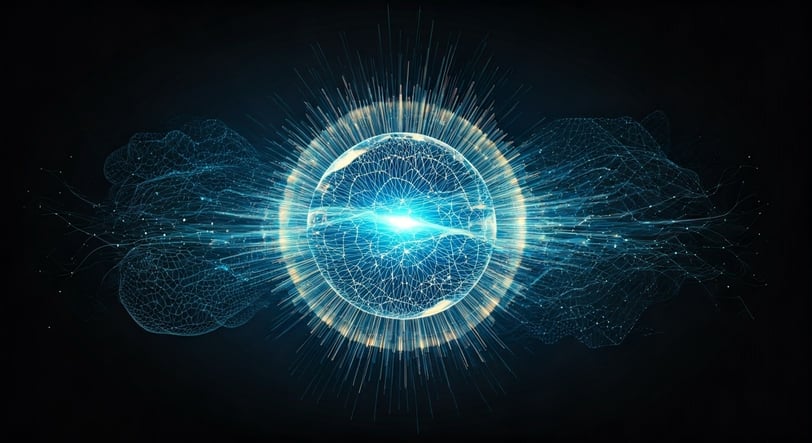
Living Intelligence: The Convergence of AI, Biotechnology, and Advanced Sensors
Living Intelligence inspires a new mix of artificial intelligence, synthetic biology, and sensor technology to build systems that change and grow on their own. This idea does not aim to replace nature with machines. Instead, it hopes to bring them together, allowing these technologies to learn from each other and improve. This exciting blend could lead to progress in many areas, like healthcare, environmental care, and manufacturing, contributing to a broader technology supercycle. As we look into this new combination, we will discover its main ideas, uses, and effects on society and technology.
ARTIFICIAL INTELLIGENCE (AI)
Key Highlights
Living Intelligence combines artificial intelligence, biotechnology, and sensor networks to develop systems that learn, adapt, and evolve like biological entities.
AI technology supports decision-making through advanced algorithms, including neural networks, enabling comprehensive automation.
Synthetic biology merges technological advancements with biological systems, fostering groundbreaking applications such as biohybrid models.
Sensor Technology plays a pivotal role in monitoring both physical and environmental parameters with enhanced precision.
Real-world applications include healthcare innovations, environmental monitoring, and efficient urban systems in smart cities.
Ethical considerations, such as data privacy and responsible biotechnology deployment, are crucial for sustainable integration into society.
Introduction
Living Intelligence inspires a new mix of artificial intelligence, synthetic biology, and sensor technology to build systems that change and grow on their own. This idea does not aim to replace nature with machines. Instead, it hopes to bring them together, allowing these technologies to learn from each other and improve. This exciting blend could lead to progress in many areas, like healthcare, environmental care, and manufacturing, contributing to a broader technology supercycle. As we look into this new combination, we will discover its main ideas, uses, and effects on society and technology.
Exploring Living Intelligence: AI, Biotechnology, and Advanced Sensors Unite
The mix of artificial and biological systems is changing how we innovate. Now, machines can not only process data but also react like living things. Living Intelligence, as seen in projects like Cortical Labs, makes it hard to tell the difference between digital computing and digital systems that relate to biological growth. It is changing how we solve problems. With advanced sensors giving instant feedback from the real world, intelligent systems are better at copying life.
By bringing together artificial intelligence and biotechnology with sensor networks, Living Intelligence could create major improvements in many areas, including potential use cases in healthcare and environmental management, as highlighted by Amy Webb. Its active nature keeps it leading the way in new advancements.
1. Artificial Intelligence: Enhancing Decision-Making and Automation
Artificial intelligence is key to Living Intelligence. It helps with smart decision-making and automation using technologies like neural networks. These AI systems look at large sets of data and learn patterns. They can make decisions in real-time, processing information more efficiently than ever before. For instance, large language models can evaluate data to predict results, making processes smoother in many industries, and could be considered the next big thing.
AI now goes beyond just predicting outcomes. AI systems have features that allow them to adjust to changing situations. This makes them more responsive to outside factors. New ideas, such as organoid intelligence, combine human brain cells with AI. This shows how hybrid models can grow and change over time.
AI tools are spreading into fields like healthcare and manufacturing. They provide a competitive advantage through smart automation. By combining machine learning with biological parts, intelligent platforms are ready to change how businesses understand flexibility and make decisions in real-world situations.
2. Biotechnology: Merging Biological Insights with Technological Advancements
Biotechnology brings important biological knowledge to Living Intelligence. It combines what we learn from biological systems with new technology to produce helpful solutions. Innovations like synthetic biology allow us to create artificial cells and tissues. These can replicate how natural processes work and connect the world of living things and digital technology.
One clear example is the field of generative biology. Here, AI systems mimic natural processes to address problems in areas like medicine and agriculture. These advancements help create biological components that can grow and change with the power of AI.
Biotechnology also enables hybrid models. These are biohybrid systems that link living tissues with digital parts. They can be used in real situations, like lab-grown neurons in medical tech or in automated systems. The partnership between AI and biotechnology leads to exciting new uses. It provides industries with sustainable and innovative options while enhancing biological intelligence in new ways.
3. Advanced Sensors: Extending the Reach and Accuracy of Technology
Advanced sensors connect the physical world with intelligent systems. They help Living Intelligence collect important real-time data. Sensor networks are becoming more advanced. They can detect heart rates, biochemical changes, and environmental conditions in great detail.
Wearable sensors, like biosensors, are changing how we monitor our health. They track vital signs and biological feedback. This technology improves personal care with continuous monitoring that meets individual needs. Environmental monitoring gains a lot from sensor networks. These networks collect valuable data on air quality, water safety, and pollution levels.
Environmental sensors are changing industries that care about the environment. They are key parts of larger intelligent platforms. When used alongside human neurons or machine learning algorithms, these advanced sensors let systems interact more effectively with the physical world. This helps improve healthcare, urban planning, and sustainability in many sectors.
Real-World Applications of Living Intelligence
Living Intelligence is changing fields like healthcare and nature with new ideas. It offers personalized medicine that changes based on what each patient needs. It also uses environmental monitoring with connected sensors. This change affects many important areas.
Cities are becoming smart cities. They use intelligent systems and AI designs to manage resources better. With sensor technology at work, Living Intelligence keeps altering industries through new ideas, showing it can make life better for people around the world. Let’s look at specific examples in healthcare and environmental systems below.
Healthcare Innovations: From Diagnosis to Treatment
Wearable biosensors are important in healthcare. They mix technology with biological systems to track health metrics such as heart rate, oxygen levels, and neural signals, playing a crucial role in managing conditions like heart failure. These sensors help people manage their health by providing real-time insights.
Furthermore, generative biology is changing drug development. It makes personalized medicine more possible. Machine learning aids in early research by predicting how molecules interact and improving clinical trials.
AI technologies also help with precise diagnostics. They analyze imaging and genetic data with great accuracy. This mix of wearable biosensors, biotechnology, and advanced AI shows great promise for finding diseases earlier, adjusting treatment plans, and improving results. As healthcare seeks better ways to operate, Living Intelligence stands out with new diagnostic tools and tailored therapies.
Environmental Monitoring: Sensors and Biology in Harmony
Environmental monitoring gets a big boost from Living Intelligence. This is thanks to networks of environmental sensors that give us important data to tackle conservation and sustainability issues, ultimately contributing to environmental protection. These smart systems watch changes in air quality, moisture levels, and nutrients in our natural habitats.
For example, intelligent platforms use these sensor networks to track environmental data for purposes like water management, fire safety, or protecting wildlife. By combining data from different sources with adaptable biological components, AI systems create actionable plans designed for sensitive ecosystems.
Living Intelligence doesn’t just monitor. It provides useful insights to face global ecological problems with quick adjustments.
Impact of Living Intelligence on Industry and Society
The wider effect of Living Intelligence reaches many industries and areas of society. It helps with automation, flexibility, and new ideas, contributing to a cycle of exponential growth. Traditional industries, like manufacturing, use biological processes and artificial intelligence to grow and improve their systems.
On a larger scale, it applies to smart city systems. These systems connect intelligent networks to manage resources well. Living Intelligence raises important questions about how it can facilitate a paradigm shift in industries, public areas, and protect the environment while promoting fast growth.
Transforming Manufacturing Through AI-Driven Bioprocesses
The manufacturing industry is experiencing a big change. AI-driven bioprocesses are using biological components to make production more efficient. These processes help machines fix themselves. This reduces downtime and costs, while also being better for the environment.
Using artificial intelligence, manufacturers design systems that can adjust to changes in the environment or how they operate. For example, they connect nutrient levels monitoring systems to digital platforms, which helps achieve sustainable production.
This mix of technologies offers a competitive advantage. It combines biological adaptability with AI predictions. As these technologies improve, production methods will change. They will help industries find new ways to be more productive and sustainable.
Smart Cities: Integrating Sensors for Efficient Urban Management
Smart cities are leading in Living Intelligence. They use sensor networks and intelligent systems to improve how cities are managed. These connected systems keep track of many things, like traffic flow and energy use. This helps with better planning for city infrastructure.
In smart cities, environmental management means using advanced sensors. These sensors check waste production, air quality, and water use. They help to create focused actions. For example, intelligent platforms can suggest energy-saving policies based on real-time data. This helps both residents and local governments.
Smart systems, powered by sensor technology, can adapt. They change how urban planning is done. This makes cities more sustainable. As Living Intelligence becomes part of resource management, cities are finding new ways to use connected technology.
Challenges and Ethical Considerations in Living Intelligence
The growth of Living Intelligence technologies brings important discussions about how we should use them responsibly and what effects they have on society. There are worries about data privacy, fairness, and making sure that people understand how these systems work when they deal with human or environmental issues.
We need to create strong ethical frameworks to manage these challenges in the United States. This is especially important in areas like healthcare or adapting to the environment. By following responsible practices, we can move forward in a way that supports society without putting crucial protection measures at risk.
Navigating Privacy Concerns in a Sensor-Connected World
The widespread growth of sensor networks in smart systems shows how crucial it is to protect data privacy. These systems gather a lot of information, which can leave people at risk of data breaches or misuse. Strong rules are very important.
AI-driven tools can also unintentionally increase biases when they process data, which can affect fairness in healthcare, environmental programs, and city projects. Finding a balance between what technology can do and what good rules say is a must for ethical responsibility.
As sensors keep spreading their reach in the digital world, we need steady actions to shield both personal rights and shared environmental interests. Clear practices and strong privacy rules are vital as connections with sensors grow in our society.
Ethical Deployment of Biotechnological Innovations
Synthetic biology combines AI and living systems and raises important questions about the rules we need to follow as it becomes more common. There are worries about regulatory frameworks because new technologies, like gene editing, can disrupt how things normally work.
When we talk about ethical responsibility, we must ensure that people understand what they are agreeing to. It’s important that the development of biological systems matches what society values, instead of just focusing on making money. For example, when making biohybrid interfaces for medicine, we need to be clear about how these will affect patients.
Working together globally, scientists, policymakers, and ethicists can create clear rules. This will help us use biotechnological advances safely. This plan makes sure that the good things will outweigh any risks or unexpected issues for society.
Conclusion
In conclusion, using artificial intelligence, biotechnology, and advanced sensors at the intersection of AI is changing how we tackle problems in many fields, reminiscent of themes in science fiction. By using these technologies, we improve decision-making and work better. This is also opening up new ways to solve issues in healthcare, environmental monitoring, and the development of new materials for smart city management. However, as we use this living intelligence, we must think about the ethical issues and privacy concerns. It is important to use these tools responsibly. The future looks bright and full of chances to change industries and make lives better. If you want to see how living intelligence can help your organization, get in touch with us today.
Frequently Asked Questions
What is Living Intelligence?
Living Intelligence, an emerging field, brings together the convergence of artificial intelligence, biological systems, and sensor technology, as highlighted by the Future Today Institute. This mix makes smart systems that can adapt and change. Unlike old systems, these new systems can grow and react to data like living organisms. This leads to new advances in healthcare, managing the environment, and city planning.
How Can Living Intelligence Transform Healthcare?
Living Intelligence, as a Living Intelligence system, is improving healthcare with new ideas like wearable biosensors and AI-driven tools. These innovations allow for the real-time checking of vital signs and neural activity. By working with biological components, it helps create better drug development and custom treatment plans. This change is making patient care much better.
What Are the Ethical Considerations of Using Advanced Sensors?
Ethical concerns about advanced sensors involve data privacy, clear sensor networks, and taking care of the environment. A promise to ethical responsibility and clear regulatory frameworks helps keep these technologies useful and fair. It also protects our social values.



